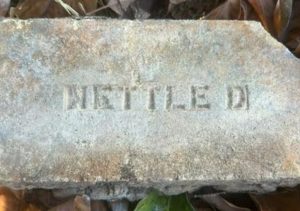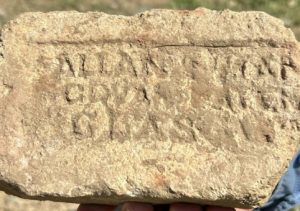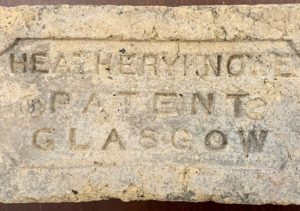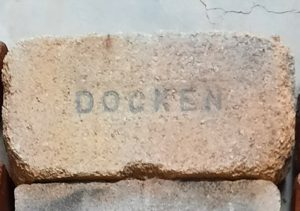Garnkirk Fireclay Works, Garnkirk, Lanarkshire.
Canmore
Info
In 1831 the Garnkirk Colliery and Brickfield Company were established and targeted the fire clay to be found in deep seams around Garnkirk and Glenboig area of Lanarkshire. The Company was owned by Mark Sprot, Garnkirk House and his brother Thomas Sprot. James Murray and Co appear to have been given the lease over the ground. The seams of clay were reputed to be of the finest quality and in a bed 4 – 19 feet thick. By May 1833 the company was advertising a full range of products including firebricks of every descriptions, tiles, gas retorts, crucibles, water pipes, ornamental vases and chimney cans. In September of 1849, Murray severed his connection with the company. For most of its life, the company was noted as having an immense wholesale home and export trade. By 1860 the company had agents in New York, Boston, Philadelphia, and Baltimore.
Below – 11/04/1831 – The Glasgow Herald – Garnkirk clay field for lease – James Murray & Co, Fire brick and Grinding Works, Port Dundas.

1832 – The Garnkirk Fireclay Company, owned by Mark Sprot of Garnkirk House, was set up. It was reputed to be the largest and most complex works in the UK at that time.
Below – 25/11/1833 – Glasgow Herald – Fireclay fields to let at the Farm of Baads, Garnkirk. (Note – SBH – I am uncertain as to this exact locus so I have recorded it here to ensure the information is saved).

Early in 1832 reference was made to the manufacture of bricks at Garnkirk but the Garnkirk and Glasgow Railway accounts reveal that the traffic in bricks along the line did not begin to develop to any extent until September 1832.
03/12/1832 – Glasgow Herald – Garnkirk chimney falls down.

Below – 20/05/1833 – The Glasgow Herald.
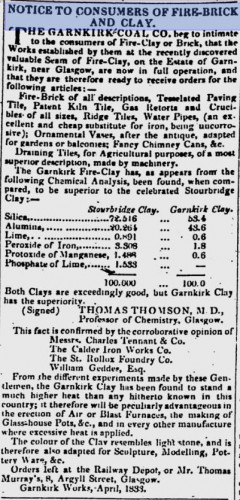
07/06/1834 – Caledonian Mercury – Grand horticultural promenade exhibition and prize show at Inverleith – an elegant vase and two ornamented flower pots manufactured from the fine fire clay lately discovered at Garnkirk were exhibited and much admired.
1835 – Firebricks the truth at last (author unknown) – John Hurll is working for the Garnkirk Fireclay Company.
Below – c. 1835 – CultureNL – Garnkirk Colliery and brickfield. Artistic impression of Garnkirk Colliery and Brickfield, owned by Messrs. Murray & Co. The drawing is possibly by R. Findlater, who also sketched Gartcloss Colliery around the same time. This is typical of the small mines which began to appear in Lanarkshire in the early stages of the Industrial Revolution. Many of these were in fairly remote locations and workers’ housing had to be built nearby. These communities often had to move elsewhere once the mines had been exhausted. The Garnkirk Colliery and Brickfield Co. (later known as the Garnkirk Fireclay Company) began in 1832, after the opening of the Garnkirk and Glasgow Railway the previous year. Garnkirk was operated by James Murray in partnership with Thomas and Mark Sprot. The Company mainly worked the fireclay deposits underground in the area covering Stepps to Glenboig, although it seems to have also worked coal. It went out of business in the early 1900s.

Below – 1836 – Baads clay field belong to Dr Jeffray, Garnkirk.

1836 – 1837 – Garnkirk Coal Co and Fire Brick Work Office, Townhead. Orders and Letters left at Thomas Murray’s, 8 Argyll Street.
14/10/1840 – Wolverhampton Chronicle – Article about iron making in Glasgow and clay quality around Garnkirk … It is curious that the clay in the neighbourhood answers perfectly for making crucibles for cast steel but it does not answer so well as Stourbridge clay for making glasshouse pots. On analysing the 2 clays we found that the Garnkirk contained much more alumina and less silica than the Stourbridge showing that glass infusion acts more powerfully on alumina than on silica.
1841 – 1842 – Garnkirk Coal Co, Firebrick office at Railway Depot, Townhead. Orders and letters left at Thomas Murrays, 8 Argyll Street, Glasgow.
02/04/1842 – Yorkshire Gazette – Glasgow was visited by one of the most severe storms of wind that has been experienced for many years …. we lament to learn that about 10 o’clock on Friday night, an accident of a serious nature occurred at Garnkirk fire brick and lime works. 2 of the stalks were blown down by the hurricane which swept over the city and suburbs and as this, unfortunately, happened to be the night on which the men at these works commenced a double shift, all those engaged in that department were buried in the ruins. By the most active exertions, the sufferers, 5 in number, were extricated from their dreadful situation. 2 of them dead and the other 3 much injured – one of them so much so that he is not expected to recover. The body of one of those recovered was almost cut in two. The names of the men killed are Daniel Mullen, a native of Ireland and John McArthur from the Highlands, both unmarried. The others are named Alexander Stark, Donald MacPherson and Alexander McPhee.
19/01/1843 – The Sydney Morning Herald, NSW – Gilchrist and Alexander, 1 George Street, Sydney have for sale 20, 000 Garnkirk firebricks, very superior quality, lying at Campbells Wharf.
11/12/1843 – Belfast Commercial Chronicle – Samuel Boyle appears to be dealing in liquor and stocking Garnkirk fire clay bricks, blocks, covers etc.
Below – 15/08/1844 – Ayr Advertiser – An experiment to convey liquid manure to fields via fire clay pipes from the Garnkirk Pottery.

.

1845 – New patents The Australian 06/02/1845 – James Murray of the Garnkirk Coal Co, Lanark, Scotland for a new method of using and applying artificial gas made from coal, oil and other substances for lighting and ventilating caverns, pits or mines or mines or other pits where minerals or metals are worked or extracted.
29/01/1845 – The Scotsman – Highland and Agricultural Society of Scotland show. Mr Murray, Garnkirk Works for an assortment of fire clay vases etc.
Below – 15/02/1848 – Greenock advertiser – A correspondent describes a journey along the Caledonian Railway and refers to Garnkirk Fire Clay Company … At the next station, Garnkirk, are situated the finest, most extensive, and handsomest fire-brick works in the kingdom, not even excepting those of Stourbridge, the fire clay of Garnkirk being, in the opinion of the celebrated Dr Thomas Thomson, superior to the Stourbridge clay. At these elegantly ornamental works, which are seen close to the line in passing are manufactured fire-brick of all descriptions, tessellated pavements, patent kiln tiles, gas retorts and crucibles, ridge tiles, water pipes, and more especially splendid ornamental vases after the antique, adapted for gardens, balconies, and buildings …

.

1849 – 1850 – Garnkirk Coal Company and fire brick and lime works at Railway Depot, St Rollox. Office 5 Cathcart Street, Glasgow.
Below – 21/07/1849 – Glasgow Gazette – New kilns at Garnkirk. Alexander Sprot. The company are ready to treat for licenses to use their patent for making brick etc from pulverised clay by hydraulic pressure.

18/01/1850 – Dundee, Perth and Cupar Advertiser – For sale, fire bricks, ornamental vases, chimney tops &c. David Davidson (Of the firm of Davidson & Methven, auctioneers) has much pleasure in intimating to his friends and the public of Dundee and neighbourhood, that he has been appointed an agent for the Garnkirk Coal Company, Glasgow, for the sale of fire bricks, clay, ornamental vases, chimney tops, &c., manufactured by them; and, from the well-known superiority of their clay and the handsome style in which the goods are got up, he hopes to receive a portion of public patronage. With the view of introducing the superior ornamental chimney tops and handsome vases into more general use, the company have instructed him to offer these goods at a very considerable reduction from former prices. Specimens may be seen, with engraved patterns, and prices obtained, at D. Davidson’s Yard, Temple Lane. The following is a list of part of the goods, which may be obtained direct from the works, or at the yard, Temple Lane, viz. Square fire bricks. All kinds of arch fire bricks. Patent compressed fire bricks, made from dry clay. Cupola bricks, for founders, circular or straight. Picked and sifted fine clay, for crucibles. Dry ground fire clay, for building. Furnace blocks or lumps, various. All sorts of fire brick fittings, for gas works. Fire clay retorts, any shape. Slabs or flue covers, for greenhouses, &c, all sizes. Glazed water pipes, spigot and faucet joints. to inches bore. Kiln tiles and flooring tiles, of fire clay, various shapes and sizes. Ornamental chimney tops, great variety. New patent wind guards, with ventilating heads, to cure blow-down or back-draught. Vent linings, straight or angled. Balustrading, various patterns. Ornamental vases, of elegant designs, and very durable.
28/03/1850 – North British Agriculturist – Ainslie’s patent kilns. I observe in your number of the 21st instant, a letter from ” A Brick and Tile Maker,” in which very free use is made of information apparently derived from the Garnkirk Brickworks. I beg to assure you that, so far as I can learn, such information does not proceed from anyone connected with the Garnkirk Company, and, whether correct or not, has been clandestinely obtained. The Company are at present giving the patent kilns a series of trials, and as the subject may be of general importance, I shall at an early period take the liberty of laying before you the result of these experiments. Up to this time, I may state that they have not proved so satisfactory as the Company were led to believe; still the Company beg to caution the public against crediting as authentic, figures and statements clandestinely obtained – Alex. Sprot, Garnkirk House.
28/03/1850 – North British Agriculturist – Improved kilns – A correspondent in your Journal, at page 181, who signs himself ” A Brick and Tile Maker,” after eight long weeks’ cogitation, plumes himself upon having made the wonderful discovery that the ” Improved Kiln,” mentioned by me in a former article, is identical with that of Ainslie’s Patent ; at least the only difference he can see is that my “Improved Kiln” has two discharging flues, while that of Ainslie’s has only one. He then proceeds to show, upon very questionable authority, that those kilns recently erected at Garnkirk, upon Ainslie’s Patent, do not at all answer their intended purpose, by reason of consuming an enormous quantity of coal and calls upon me to compare the quantity consumed by them, and that stated by me as required for mine, ” both of which,” in his opinion,” are of the same construction.” I see no necessity for my doing so, especially having only such dubious authority to go by. l am quite satisfied with the results of the well-matured experiments my ” Improved Kiln” has been subjected to, and that it is quite distinct from that of Ainslie’s Patent, both in the mode of construction and the cost of erection. There are a class of persons who have the peculiar facility of observing with a “jaundiced eye,” everything in the shape of an improvement that emanates from any other source than that of their own narrow circle. To such a class I am apprehensive your correspondent belongs, otherwise, he would have more carefully examined the sketch I sent you, and compared it with that of Ainslie’s Patent: he would thus have seen that the two were not identical. I am very much of opinion that your correspondent’s only acquaintance with Ainslie’s Patent Kilns is that of the name; for as he himself says he only saw the one referred to at Garnkirk during the process of burning, or when it was ” but half burned off”—rather a singular time, I must confess, to examine the construction of a kiln while he has never seen mine either in operation, or otherwise, excepting the sketch referred to, which, if it be any satisfaction to him, I am free to confess is not drawn in an artistic manner, but yet, withal, sufficiently plain to be understood by any person having the slightest pretension to a knowledge of building Kilns. As I before said, I see no necessity for my comparing the quantity of coals consumed at Garnkirk, and that stated by me in my former article, as required by mine. What I then stated were facts, and see no reason to alter it, but I will state in addition that my “Improved Kiln” has been filled with large blocks of fire clay, some of them containing six cubic feet of clay, and that with the same quantity of coal. That, I should say, was sufficiently corroborative of the statement I formerly made. As to my having ” jumped at conclusions,” it is pretty evident that your correspondent alone has “jumped at the conclusions” he draws. He attempts to be witty, and twits me with naming myself “A brick and tile maker of the new school” he appears to be apprehensive that were I to be examined by a “competent judge”, I might be found “to be at the very bottom of the old school”. I would be most happy, should your correspondent give his name, to be examined by him, in the presence of “men of experience and stability” and he might in all probability, have a more difficult task to perform than would be agreeable to himself—the more especially if in any way connected with the “would be” Improved Kiln. Should your correspondent be capable of deriving any benefit from seeing my ” Improved Kiln” he has only to furnish me with his name through your journal, and state the day he intends coming, so that I may not be from home, as I do not allow my men to show the kiln in my absence, more especially to nameless strangers; he can then see the “object of his ridicule”. I quite agree with your correspondent that it would be a useful subject to be taken up by the Highland Society, but I fear if your correspondent’s article is to be taken as a specimen of his knowledge of patent kilns, or any other kilns but on the old system, that he would not be a competent person to examine mine if its capabilities were to be properly and truly reported on. I have no earthly objection to my name and residence being known, but it savours very much of the “dog in the manger” style by your correspondent’s finding fault with me for writing anonymously, while he himself practices the same thing; one would suppose that to write anonymously was the exclusive right, or patent, of “A brick and tile maker,” and not of “A brick and tile maker of the new school”
Below – 10/04/1850 – Derry Journal – Advert.

02/08/1850 – Glasgow Herald – Highland and Agricultural Society’s Grand Show in Glasgow – The Garnkirk Works have also sent in their quota of articles for exhibition. Here we find vases, modelled in the finest style of the art; busts of Watt and Henry Bell, executed with surprising accuracy and taste; ornamental chimney cans, &c; and, what is perhaps in most germane to the grand object of the exhibition, specimens of all sizes of salt-glazed pipes, both for drainage and general purposes. Ferguson and Miller, Heathfield Works, have also a numerous selection of articles of the same description, including a magnificent Warwick vase, the execution and modelling of which reflect great credit on the taste and skill of the designer.
Below – 12/10/1850 – The Daily Crescent – New Orleans – Brick quality ‘test’ carried out between a Garnkirk and Biloxi fire bricks.
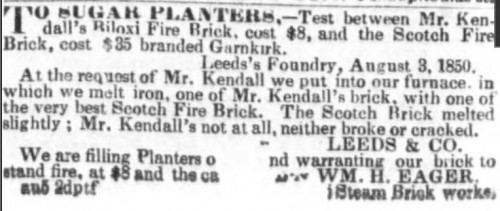
1851 – ‘Garnkirk Fireclay by G Quail’ – Neighbouring Fireclay Works: Cardowan. One of the most significant figures during the early years of fireclay manufacturing in Scotland was John Hurll, who seems to have come over from Ireland about 1835 to work for the Garnkirk Coal Company. In 1851 he was described as ‘brickyard operations manager’ at the Garnkirk Works. Soon afterwards he joined forces with John Young to establish fireclay works at Cardowan.
Below – 1852 – Garnkirk Fire Clay Works Advert – Slaters Directory.

Below – 1853 – Garnkirk Coal Company, Garnkirk Works, Glasgow. Frontpage of their catalogue (photocopy). At this time they have agents based in New York, Boston, Philadelphia and Boston, USA.

07/02/1854 – Dundee, Perth and Cupar advertiser – Advert – William McLaren, The Yard, West Port, Dundee is stocking Garnkirk fire clay goods … The superiority of the articles manufactured by the Garnkirk Company is so well known that it is only necessary to say that they comprise – fire bricks, fire clay, drain pipes, vent linings, chimney cans, and ornamental vases in great variety, grate bricks of all sizes and tessellated paving tiles, balcony rails etc …
03/10/1854 – The Sydney Morning Herald – Purkis and Lambert will sell by auction 11,000 Garnkirk firebricks in fine condition and well adapted for making pavements!
Below – 07/12/1854 – Northern Warder – Garnkirk advert. W McLaren Agent.
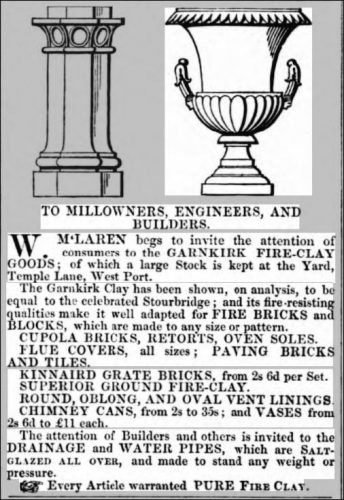
Below – 10/11/1855 – The Garnkirk Coal Company, Garnkirk Works, Glasgow William Henderson, an agent in Ulster.

11/02/1856 – Glasgow Herald – Garnkirk Works – At two o’clock on Thursday morning a large chimney of 120 feet, connected with the fire brickwork, was blown down, carrying away a piece of a stove and a dwelling house in which one of the foremen and his family were asleep, burying them in the ruins. Happily, they escaped with some slight bruises. two of the engine stalks of chimneys connected with the coal and fire clay pits were also blown down, and a large fenced wall around the works gave way at the same time. The houses were stripped of cans, slates, &c. At Heathfield, an adjoining fire brickwork, one of their largest stalks or chimney was blown down. Coatbridge.
Below – 13/03/1856 – Caledonian Mercury – Court of Session. Caledonian Railway etc V Mark Sprot. A dispute over lost mineral rights.

.

.
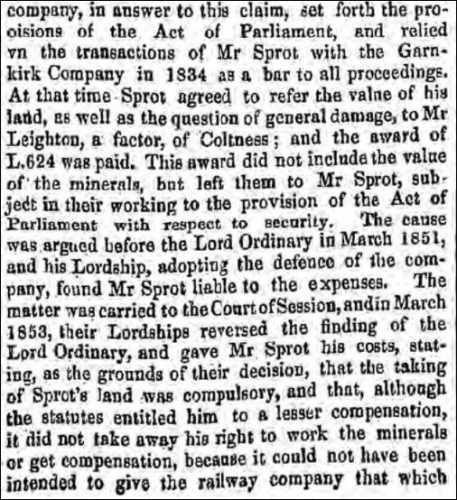
.

Below – 07/06/1856 – Aberdeen Herald – Garnkirk Coal Company. G Duncan, Netherkirkgate – Agent.

1857 – Garnkirk Colliery and Brickworks Lanark. J Gillespie Manager, Muirhead.
Below- 21/04/1857 – Northern Whig – William Henderson agent in Belfast.

Below – 02/05/1857 – The Advocate – Henry Perrin, Ireland agent for Garnkirk Fire Clay Company.

07/08/1857 – New York Daily Tribune – Building materials. Garnkirk and American chimney tops, also best glazed and vitrified drain pipes at Long Island Pottery Depot, No 52 Naseau Street – E. H. Quinn – also – Encaustic tiles for vestibules, halls, hearths, dining rooms, conservatories &c Garnkirk chimney tops, drain pipes &c for sale by Miller & Coates, No 279 Pearl Street, New York.
Below – 1858 – Garnkirk Fire Clay Works.
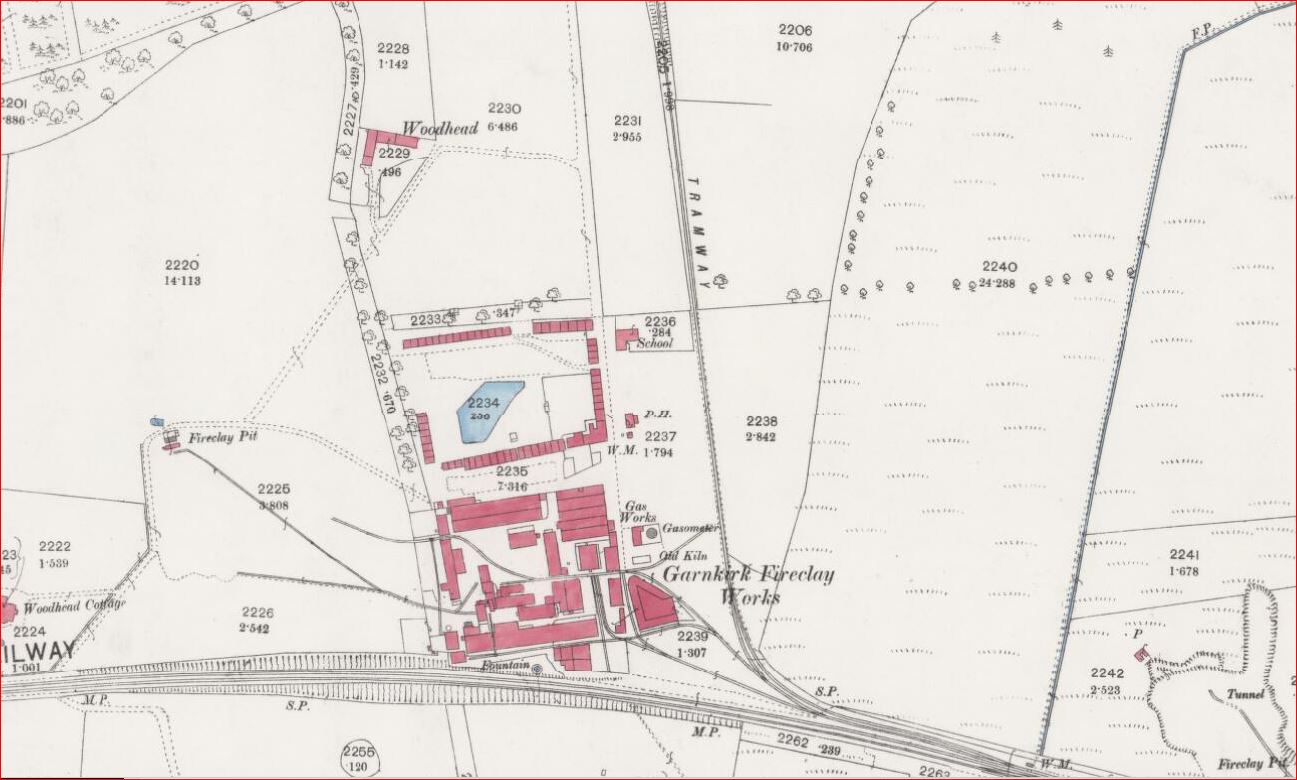
1858 – 1859 – John Cannan, salesman, Garkirk Coal Company, fire brick manufacturers, 243 Buchannan Street, Glasgow. House 14 Ure Place.
Below – 24/07/1858 – Aberdeen Herald – Garnkirk Coal Company. G Duncan, Netherkirkgate – Agent.

20/08/1858 – Belfast Morning News – Fire bricks of every description and size. Furnace blocks, flue covers, chimney cans, vent linings, gas retorts, sewage and water pipes, vases, fountains, balustrading; fire clay, ground and selected: Manufactured at the Garnkirk Works, near Glasgow. A large stock always on hand, and for sale by William D. Henderson, agent for Belfast. Fire, Life, and Marine Insurance Office, 42, Waring Street.
18/08/1860 – Scottish Banner – Sudden death. On Tuesday afternoon, a carter named Hugh Connel, while loading his cart at the Garnkirk Brickwork, became suddenly ill and was at once removed home to his residence in Parson Street, where he expired. Dr Clews is of opinion that death resulted from palpitation of the heart
Below – 28/09/1860 – Belfast News – Garnkirk fireclay goods for sale in Belfast.

Below – 1861 – Advert Garnkirk Coal Company and Brickworks, Glasgow

Below – 28/02/1863 – Coleraine Chronicle – Garnkirk Fire Clay and Terra Cotta Works show off drawings and designs.

01/07/1864 – Montrose Standard – Garnkirk fireclay goods. Durie and Brand, agents, 7 Market Street, Montrose have in stock ground fireclay, fire bricks, square arch and cupola grate bricks, flue covers, paving tiles, cattle and pig feeding troughs, sewerage pipes, vent linings, plain and ornamental chimney cans, figures and vases &c. Every description of fireclay goods made to order. Knight, Bevan & Sturges London, Portland and Roman cements. These goods which are admitted to be the best in Scotland and being greatly reduced in price, we hope still to be able to compete with those of inferior manufacture. 24/06/1864.
04/07/1865 – Belfast News – Scotch Fireclay goods – Scottish fire clay goods. Builders, Contractors, &c., will find the largest and most varied Stock of the above Goods kept in Ireland at my Depots- Queens Quay, Belfast and 56, North Wall, Dublin The Goods are second to none in the market and at lowest rates, white bricks (extra finished), for Facing, Buildings, in great variety. Also, glazed sewerage pipes, with Patent or Socket Joints. Robert Brown.Belfast Depot- Queens Quay. Dublin Depot-56 North Wall. Works Paisley. N.B.- Goods can be sent to any Port in Ireland, either by Sailing Vessel or Steamer, direct from the Works. 4235
The subscribers have for sale:-Garnkirk fire brick and clay; Allan & Mann’s white building brick (the best brick manufactured); J. & M. Craig’s brick, 1st and 2nd qualities; Do, white and red glazed tiles; Sealy’s Bridgewater tiles and Bath brick; Staffordshire black brick, various shapes; Chester tiles and brick
Architectural Pottery Company’s ornamental tiles, cement, London, Portland, Roman; Hydraulic limes, &c.; chimney cans, water pipes, &c., &c., &c.
W.D.Henderson & Sons. Office-14 Corporation Street. Yard – Albert Square. 4113.
02/10/1865 – Glasgow Herald – Patents recently applied for – Sept 19 – James Gillespie, Garnkirk – brick and tiles.
Below – 14/07/1866 – The Sydney Morning Herald – Balmain Firebricks – Bradford & Co

Below – 1867 – Advert Garnkirk Fire Clay Co
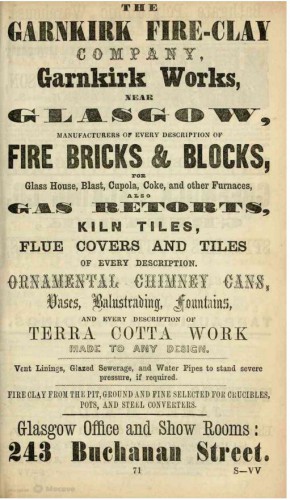
1868 – Garnkirk Coal Company, Garnkirk Brickworks, Moodiesburn, Glasgow.
Below – 23/04/1868 – Falkirk Herald – H. Hume appointed an agent for Garnkirk Fire Clay Company.

Below – 28/11/1868 – The Scotsman – An article on the background to brick making and highlighting the Garnkirk Fire Clay Company … (The Industries of Scotland by David Bremner). There are in Scotland 122 manufactories of brick, tiles, and articles of a similar nature; and in connection with these from 4000 to 5000 persons are employed. The manufactories are widely scattered over the country, the farthest north being at Banff and the farthest south at Dalbeattie; but the greater number are in Lanarkshire and Fifeshire, in which counties valuable beds of fire- clay exist. The most extensive is that of the Garnkirk Fire-Clay Company, situated on the Caledonian Railway line about six miles east from Glasgow. The company was originally formed to work coal, but, finding that extensive seams of fire-clay existed on their property, they took to manufacturing that material, which now almost exclusively engages their attention. The principal seam of clay is seven feet in thickness and lies at an average depth of twenty- eight fathoms. Its quality is considered equal to that of the best Stourbridge clay. The manufactory covers upwards of six acres of ground. The raw material is brought in, and finished goods are sent out by branch railways. 300 men and boys are employed, and 200 tons of clay and about an equal weight of coal are used daily. The clay is of a dark colour, owing to the presence of a small proportion of bituminous matter; but when that is dispelled by the action of fire, only silica and alumina remain, and it is the presence of these substances in certain proportions that decides the value of the clay. As it comes from the pits the clay is entirely devoid of cohesion or plasticity; and in order to bring it into working condition, it has to be ground. very fine, and then mixed with water. Several powerful mills are used for this purpose. They consist of great iron rollers, which travel round a circular trough, and pass over the clay.
Bricks are the commonest and simplest articles made. Some ingenious machines have been devised with a view to superseding hand labour in this branch of manufacture; but as yet hand labour has the advantage of greater economy. Indeed, the item of moulding, to which only the machines could be applied, forms a small part of the labour in brick-making. At Garnkirk all the bricks are hand-moulded, which is a very simple process and is executed with wonderful rapidity. An expert moulder, with the necessary assistants, to keep him supplied with clay, and to remove the moulds as they are filled, will make from 4000 to 5000 bricks a-day. The moulder works at a table, on one end of which is a supply of clay, the other being left clear for his operations. The bricks are formed in a deal framework, resembling a small box with the top and bottom removed. A boy dips the mould in water and lays it on the table. The moulder, taking up a lump of clay, dashes it into the mould, presses it with his hands, and then removes the superfluous clay by drawing a piece of wood over the mould. His assistant, who has meantime laid down an empty mould, snatches up the full one and deposits the newly formed brick on the floor of the workshop. Thus the work goes on until the floor is covered. An important matter in the manufacture is to take care that at least 25 per cent. of the water contained in the clay is evaporated before the bricks are subjected to burning. In some places, and in the case of common bricks, it is usual to expose them in the open air before firing; but that is a precarious practice in a climate like ours, and the best plan is to dry them undercover by artificial heat. The Garnkirk brick-sheds, and the drying-rooms in the other departments, are fitted with pipes through which the waste steam of the engines is made to pass, and by the heat which these give off the bricks are brought into firing condition in the course of twenty-four hours. The bricks are fired or burned in kilns, but another mode of firing is sometimes employed in which the bricks are built-in ” clamps,” or large square heaps with layers of fuel between. Kiln baking is the best. The kilns are built-in ranges of three or four together, the smoke from all of which is drawn off by one chimney. Internally, the kilns are about 12 feet in length, breadth, and height, and the bricks are arranged in them so as to allow the fire to act freely on all. About 20,000 bricks are placed in each kiln, and the baking occupies six days and nights. Flooring tiles are made after much the same fashion.
The improvement of agriculture, and the consequent increase of draining, has within the past twenty or thirty years led to a great and increasing demand for clay drain-pipes, and many millions of these are produced in Scotland every year for both home use and exportation. They are made of common red clay—a much softer and less durable substance than fire-clay. The pipes are formed by ingeniously constructed machines, which turn them out at a rapid rate.
The Garnkirk Company do not work in common clay, and make no agricultural drain-pipes, but they have an extensive trade in the manufacture of glazed fire-clay sewage and water-pipes. As already– stated, clay pipes were used by the Romans to carry off the sewage of their towns and villages. The city of Rome had a complete system of sewage. There were main sewers built with bricks, and branch sewers consisting of pipes of wood or clay. With the decline of the Roman Empire draining as well as many other good things went out of use, and modern minds were only awakened to the importance of the matter when thousands of persons were carried off by diseases which could be traced to no other origin than defective drainage. The importance of providing means to carry away filth from centres of population is now generally known and understood, though in some cases action is tardy. For main sewers, nothing better than brick has been devised, and for branches, nothing better than clay pipes—so that, in the all-important matter of town drainage, we are no further ahead than were the people who occupied the foremost rank of civilisation two thousand years ago; and it is not long since equality could be claimed. The making of sewage-pipes is an important branch of the manufactures in clay. The pipes are formed by pressing the clay through a die. They are made in lengths of three feet, and each piece has a “collar” worked on one end. After being dried in the stoves the pipes are baked in large circular furnaces. In the course of the baking, a quantity of salt is thrown on the pipes, and that combining with the silica of the clay forms a glaze which covers the entire surface. The pipes are made from two to thirty-six inches in diameter. The heaviest articles made are gas-retorts and blocks for the furnaces of glasshouses. Some of the latter weigh fifteen cwt.
Works in terra cotta are also among the productions of the Garnkirk Company. Terra cotta is an Italian term signifying baked clay, but it is commonly employed to designate such articles formed of clay as are used in architectural embellishment. It is, if properly made, one of the most durable materials that can be used in building. It was so employed by the Egyptians, Greeks, and Romans, and by various European nations in the middle ages. Monumental vases in terra cotta have been recovered in a state of perfect preservation from tombs in which they had been placed upwards of two thousand years before, and examples are not wanting to prove the weather-resisting powers of the material. Sutton House, in Surrey, built about the year 1530, is covered with ornaments in terra cotta, which yet retain the marks of the artist’s modelling tools …







1869 – Garnkirk Fire Clay Co. Manufacturers of fire bricks & blocks tor the highest heats for iron blast furnaces; forge, rolling, puddling, and steel furnaces; pottery, bottle and flint glass furnaces; copper calcining, roasting, & refining furnaces; chemical Works, coke ovens, locomotive bricks, &c. ; special bricks for Siemen’s patent regenerative gas furnace; Glazed sewerage pipes, ornamental vases, fountains, and all kinds of terra-cotta work. Registered trademark, ” Garnkirk.” Office & showrooms, 243 Buchanan St; works, Garnkirk, near Glasgow.
23/08/1870– Glasgow Evening Citizen – Garnkirk Fire Clay Company showrooms – 243 Buchanan Street, Glasgow. Garden vases, fountains and other ornaments. Cheap durable and beautiful.
26/10/1870 – Londonderry Standard – M. McClelland. Londonderry, Agent for the Garnkirk Fire Glay Company’s celebrated fire clay goods.
1871 – International Exhibition, London – Pottery – Terracotta, Stoneware, firebricks – page 70 states – The Garnkirk clay (near Gartsherrie, Scotland) is bituminous and mixed with some sulphur and almost free of sand. After weathering for 2 or 3 years, it is used almost dry and without the addition of burnt clay. It is the most refractory clay known.
Page 72 states – … the burning takes place at Garnkirk, in rectangular kilns; the flame enters and ascends at the side, between the bricks, descends in the centre and thence enters 2 chimneys.
Below – 1871 – Liverpool Shipping Guide.
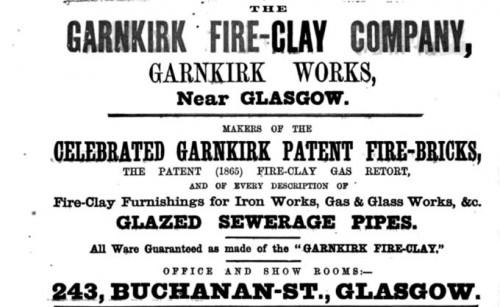
May 1871 – Garnkirk Fire Clay Company advertise a new design for a chimney top.

27/10/1871 – The Brisbane Courier – Arthur Martin has received instruction from Messrs Scott, Dawson and Stewart to sell 7,000 Heatheryknowe firebricks and 3,700 Garnkirk firebricks.
17/05/1872 – Belfast News – Fire bricks, pipes, tiles – we are now discharging a cargo of the celebrated Garnkirk fire bricks, blocks and clay; also glazed sewer pipes, chimney cans, white and glazed tiles, wall coping, troughs, jaw boxes etc from J & M Craig, Kilmarnock. Slates, cement, alabaster, flagging etc in stock, all at low prices. W.D Henderson & Sons, 12 Victoria Street, Belfast.
In 1878 the principal overseas markets were in France, Germany, Russia, and the East and West Indies. Products are also noted as being shipped to New Zealand. By the 1860s the company was the largest fireclay firm in the world covering six acres, employing 300 men and boys, and manufacturing 200 tons of fireclay products each day.
By the late 1860s, the firm was surpassed by J. & M. Craig of Kilmarnock, which in turn was surpassed by the Glenboig Union Fire Clay Company in the 1880s. The Garnkirk fireclay pits were finally exhausted around 1895.
Apparently, the company went out of business around 1898 and the buildings were being advertised for sale in the spring of 1901. By 1979 the land previously worked by the Garnkirk Fireclay Works was lost under a new housing scheme.
05/06/1872 – The Brisbane Courier – To sugar planters and others, Scott Dawson and Stewart, Creek and Elizabeth Streets, Brisbane – 3,000 Garnkirk firebricks for sale.
27/07/1872 – Dundee Courier – Dundee town council have met and the offer to erect the fountain in the New Park at a sum of £105 by the Garnkirk Fire Clay Company has been accepted.
03/10/1873 – South Wales Daily News – Wolsingham Park Dinas and Fire Brick Mineral and Coal Company Limited, Newcastle upon Tyne prospectus. Capital £70,000 with power to increase in 7,000 shares of £10 each … In regard to fire bricks, the Garnkirk, one of the best in Scotland, is now quoted in Glasgow at £5 per thousand and the Wolsingham Park are expected to be superior to these. The estimated cost of such bricks being 34s per thousand and taking the nett profit at 36s per thousand, which, on a yearly make of 10,400,000 shows an estimated profit of £18,726 …
22/06/1875 – The Sydney Morning Herald, NSW – Cardowan, Garnkirk firebricks – Mason Brothers.
15/11/1876 – The Sydney Morning Herald – Being sold by Mason Brothers, Spring Street, Sydney – Garnkirk firebricks.
1877 – 1891 – Invoices – Various. All state The Garnkirk Fire Clay Co. Office and showrooms 243 Buchannan Street, Glasgow. Manufacturers of fire bricks and blocks, flue covers, fire clay, glazed sewerage pipes, paving tiles, retorts and of all kinds of gas work furnishings. In addition, the 1877 invoice has to the rear ‘ornamental vases, figures, fountains, balusters, trusses, ridge tiles and chimney tops, manufactured by the Garnkirk Fire Clay Company, Garnkirk Works, near Glasgow. Specimens may be seen there or at their office and showrooms 243 Buchannan Street, Glasgow. Drawings and price lists sent on application. The 1891 invoices also have this added information – Telegraphic address ‘fireclay’ Glasgow. Trademark ‘Garnkirk’.
26/05/1877 – The Sydney Morning Herald – Being sold by Mason Brothers, Spring Street, Sydney – Garnkirk firebricks.
Below – 18/08/1877 – The Coleraine Chronicle – Advert for Garnkirk goods in Coleraine. Agent D.A Williamson & Co.

1878 – Garnkirk Fire Clay Co -243 Buchannan Street, Glasgow. Works – Ganrkirk. Deport St Rollox.
1878 – John Cannan, firebrick manufacturer, (Garnkirk Fireclay Co), Eildon Terrace, Patrick.
Below – 1878 – Garnkirk Fire Clay Co advert.
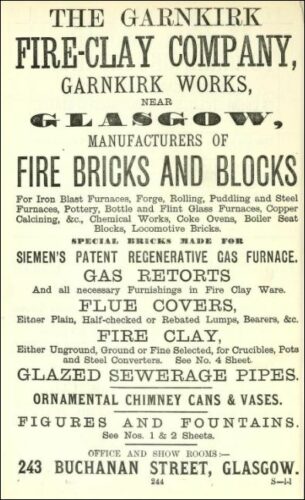
03/09/1878 – Cork Constitution – Wrixon and Weir agents for the Garnkirk Fire Clay Company Cook Street, Cork
12/10/1878 – Northern Constitution – Special notice – We are at present discharging ex ship “Mary” a cargo of the celebrated Garnkirk Fire Clay Goods, consisting of sewerage pipes, chimney tops, feeding troughs, flue linings, bricks, tiles and garden vases … Coleraine 31/08/1878.
1880 (?) – Fire clay goods, slates and cement. W.D Henderson & Sons, 12 Victoria Street, Belfast. (Scottish Amicable Buildings)
Always supplied with Garnkirk and Kilmarnock best Tiles, Fire and Facing Bricks, ‘Cans, Vases, Glazed Sewer Pipes, Troughs, and all Articles made in Fire Clay and Terra Cotta, including Staffordshire Blue Bricks, Plain and Encaustic Tiling, Field Drain Pipes, Roofing Tiles, etc., also White Bros’, celebrated London Portland Cement, Lias Lime, Alabaster, Slates, Flagging, Newton’s Patent Gullies, Allan & Mann’s Patent White Bricks, Oven Tiles, Laths, Buchan’s Traps etc.
Yards – Albert Square, foot of Waring Street and Corporation Square, next to Harbour Office.
Below – 28/02/1880 – Staffordshire Sentinel – Registered pottery trademarks.

07/06/1881 – Waterford Corporation pay £78 3s 4d to Garnkirk Fire Clay Company to cover the cost of a new fountain to be erected in the Peoples Park, Waterford City, Republic of Ireland.
Below – c. 1900 – A photo of the fountain.

Below – 1982 – A group of 45 – 60 young men from Dublin destroyed the Peoples Park fountain after they were removed from a train and refused onward travel to the seaside resort of Tramore. No one was charged with the damage.

1882 – Garkirk Fire Clay Co – Terracotta manufacturers, fire bricks, blocks for glasshouses, blast, cupola, coke and other furnaces, gas retorts, kiln tiles, flue covers, chimney cans, vases, balustrades, fountains, vent linings, glazed sewage and water pipes. James Gillespie Manager. Office 243 Buchannan Street, Glasgow
05/01/1885 – Aberdeen Free Press – Aberdeen Town Council. Gasworks contract …The Gas Committee have accepted the following tenders for the supply of materials in connection with the undertaking for the ending 31st December 1885 … fire clay goods – Garnkirk Fire-Clay Company and J. & C. Grieve. The committee had also before them tenders for the lightning conductor, and for the supply of circle and header bricks for the new chimney stalk, and authorised the gas treasurer to accept the following: Bricks – Robert Fleming and Co. (Atlas or Calder Fire Clay Works?)
Below – 1886 – Advert Garnkirk Fire Clay Co, Near Glasgow.

24/07/1886 – London Daily News – Prospectus for Thomas Carr and Son, Fireclay manufacturers … The new gas process is already in operation in some of the largest Fireclay and Brick and Tile Works in the Kingdom, amongst which are the following: Glenboig Star and Cumbernauld Fire Clay Works of the Glenboig Union Fireclay Company and the Garnkirk Fireclay Works …
12/07/1887 – The Brisbane Courier – Parbury Lamb & Co now have to arrive aboard the Peebleshire from Glasgow – Garnkirk firebricks.
19/07/1888 – North British Daily Mail – The International Exhibition, Glasgow … In Court 4 the Garnkirk Fireclay Co have a stall which must always, from the handsome appearance of some of the exhibits, arrest the attention of the passing visitor, apart from any interest he may have in the many useful articles shown. The very durable quality for wear and resistance to weather, fire, and other corroding influences of the Garnkirk Fireclay are well known. Its fine, creamy grey tone of colour also adapts it for many decorative purposes. Several fine examples of its adaptatian to this latter purpose are shown. Among these, a colossal female figure, artistically modelled, is prominent in the centre. It stands 8′ 6″ in height, and represents a draped female crowned with leaves, and having a wreath in her hand. Lesser figures of Minerva and Bacchus, forming a pair, and of a gleaner are equally well modelled; and another pair, a lion and lioness and cub by Ferguson, are a remarkable contrast in their life-like forms to a style of work not uncommon in this class of material. If the company had done nothing else than show these really fine figures as a suggestion of what may be accomplished for such outdoor work, they would have justified their place in the Exhibition. But these are not the only articles of taste in the exhibit. A number of handsomely designed vases are also shown as specimens of the large series in varied styles made by the firm. A sundial which, apart from actual violence, might last for ages, stands on the floor of the stall with the exception of the indicating gnomon which are of sheet copper. It is entirely made of the enduring fireclay, the circles, numbers and other marks for indicating time being indented in the material. This dial, besides showing the time in this country, with corrections for different periods of the year, gives the time also in New Zealand, at Malabar, at New York, and at Alexandria. A huge part of the space is, of course, occupied with articles of especially practical use, such as chimney cans and balusters, in each of which there is a very great variety of patterns, to fit in with every style of architecture. Bricks of various forms, with and without enamelled faces, paving and flooring tiles in different patterns and sizes, and other articles for which the special qualities of the material recommend it are also shown. In Garnkirk adamantine mineral, which is said to be perfectly impervious to moisture, flooring tiles, channel runs, stable and foundation bricks, and sanitary pipes of all kinds are among the manufactures of the company, and specimens are shown on the stall. In this material too, well as in the Garnkirk Fireclay, border tiles for garden walks are shown in several pretty patterns.
25/08/1888 – Lennox Herald – International Exhibition, Glasgow – Sanitary section – The Garnkirk Fire Clay Co, Glasgow, have a display of sanitary pipes, with all their latest improvements. They have also a good number of artistic articles, such as statues, vases, and a sun-dial, all in fire clay. Also, chimney cans and fire bricks for furnaces and ornamental buildings.
Below – 1889 – Advert Garnkirk Fire Clay Co, Near Glasgow.


1890- 1891 – William Burnside – Depot Manager, Garnkirk Fire Clay co, Head of Glebe Street, Glasgow.
1890 – 1891 – John Cannan, fire clay manufacturer and merchant, 133 St Vincent Street, Glasgow. House 20 Lawrence Place, Paisley.
1891 – The Garnkirk Fire Clay Company, Garnkirk Works, near Glasgow. The founder of this, the largest concern of the kind in Glasgow or for many miles around, commenced business some sixty years ago. (1831) The Company engages extensively in the manufacture of fire bricks and blocks for the highest heats, for iron blast furnaces; forge, rolling, puddling, and steel furnaces; flint and bottle glass furnaces; pottery, copper calcining, roasting and refining furnaces; chemical works, coke ovens, locomotive bricks, gas retorts, flue covers, ornamental chimney cans, vases, figures, fountains, and every description of terra-cotta work. For the whole of the long period during which the Garnkirk fire clay has been known throughout the world, its supply has been inexhaustible. This clay differs from that from which other Scotch fire clay goods are made in being comparatively free from iron, the presence of which in quantity is not only dangerous as a flux but wasteful, as owing to its power as a conductor it causes great heat radiation.
The Garnkirk Works, which cover an area of thirty-five acres, is situated, in near proximity to the Caledonian Railway system, at a distance of about six miles from Glasgow. The Company was originally formed for the purpose of working coal, but, finding that extensive beds of fire clay existed on their property, the Company took to manufacturing that material which now almost exclusively engages their attention. The principal seam of clay is seven feet in thickness and lies at an average depth of twenty-eight fathoms. Its quality is considered by competent connoisseurs to be equal to that of the very best of the Stourbridge clays. The works of the Company are intersected by branch railway lines, between three and four hundred men and boys are employed. The clay is of a dark colour, owing to the presence of a small proportion of carbonaceous matter, but which is expelled by the action of fire, silica and alumina only remaining, and it is the presence of these substances in certain proportions that decides the value of the clay. As it comes from the pits the clay is entirely devoid of cohesion or plasticity; and, in order to bring it into working condition, it has to be ground and then mixed with water. Several powerful mills are used for this purpose. They consist of great iron rollers which travel around a circular trough and pass over the clay.
The Garnkirk Company do not work in common clay, but they have an extensive trade in the manufacture of glazed fire clay sewage and water pipes. The terra-cotta work of the Company is unsurpassed by that of any other enterprise of the kind in the Kingdom. Terra-cotta is an Italian term signifying baked clay, but it is commonly employed to designate such articles formed of clay as are used in architectural embellishments. It is if properly made, one of the most durable materials that can be used in building, and was so employed by the Egyptians, Greeks, and Romans. The articles made at Garnkirk Works in terra-cotta are chiefly statues, fountains, vases, brackets, pedestals, and chimney pots.
There are many indications that the developments of this great concern will be continuous. All who have used the various productions of the Garnkirk Fire Clay Company pronounce them in every respect unequalled in the market, and the judicious and, withal, enterprising policy pursued by the Company in the management of the business encourages the belief that the achievements of the house in the past are but antecedent to the attainment of still higher future ends in the industry, so admirably illustrated at Garnkirk Fire Clay Works, and at the extremely commodious offices and showrooms of the Company at the corner of Buchanan Street and Sauchiehall Street, and at the fire brick depot at the head of Glebe Street, St. Rollox, Glasgow.
Below – 06/04/1892 – Glasgow Herald – Garnkirk Fireclay Co advert.

Below – 1893 – Advert – Garnkirk Fire Clay Co
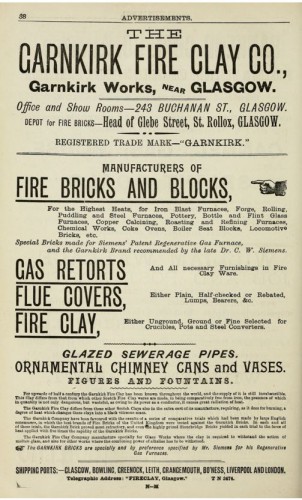
Below – 1893 – 1896 – Advert – Garnkirk Fire Clay Co.
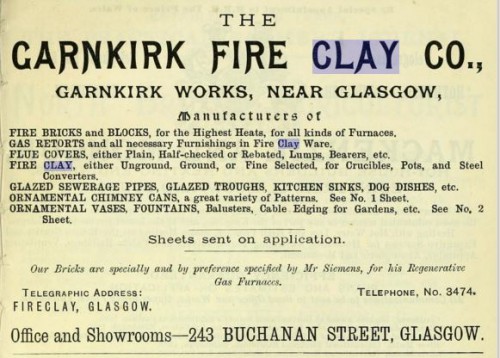
14/03/1895 – Glasgow Herald – Garnkirk Fire Clay Company, 243 Buchanan Street, Glasgow – Garden vases. Catalogue free.
Below – 1896 – Advert Garnkirk Fire Clay Co.
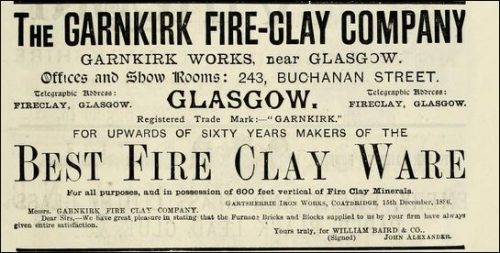
Below – 1896 – Advert Garnkirk Fire Clay Co.
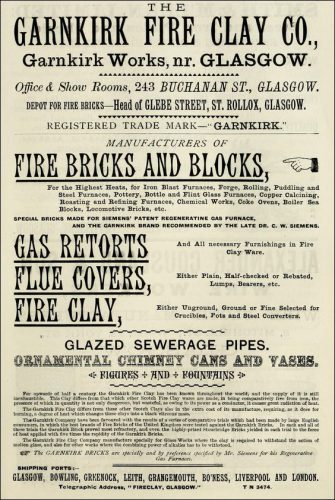
Below – 1897 – Garnkirk Fire Clay Works.
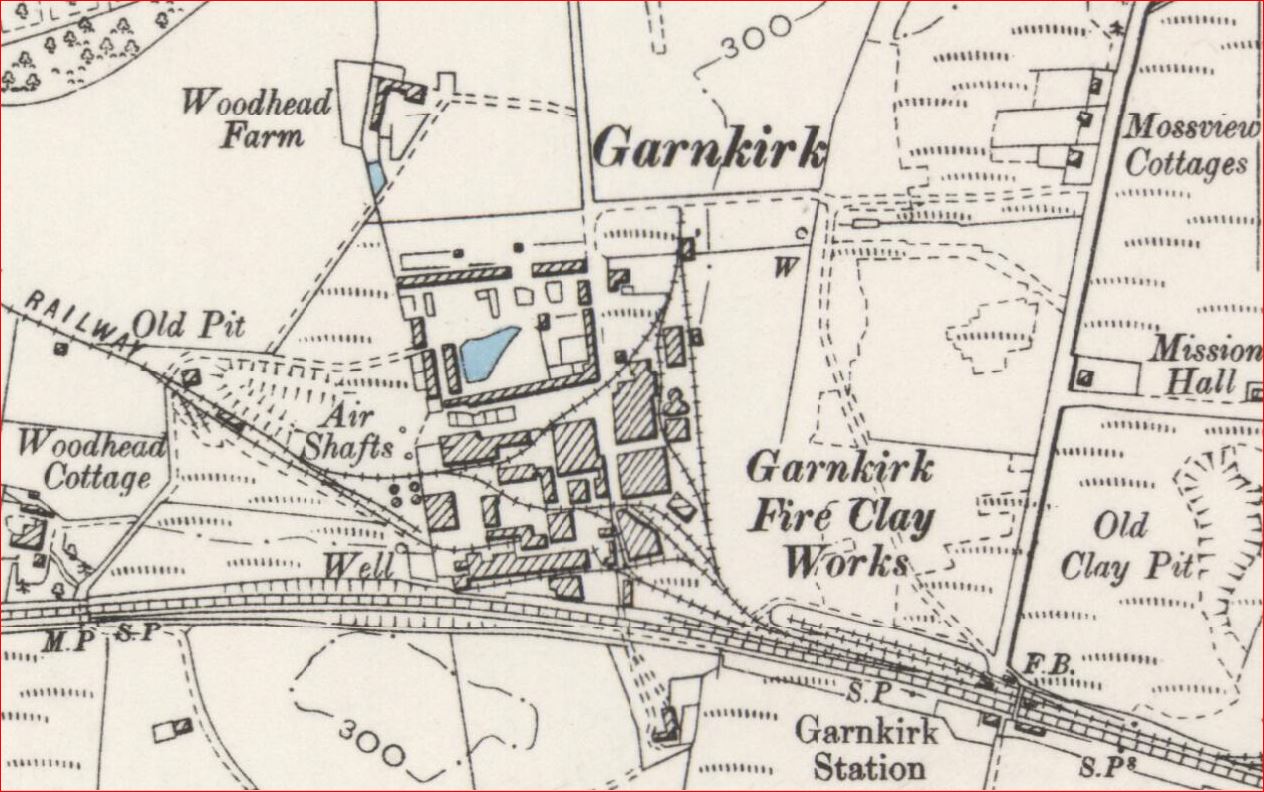
10/08/1897 – Clyde Bill of Entry and Shipping List – The Garnkirk Fire Clay Company, 243 Buchanan Street, Glasgow. Our bricks are specially and by preference specified by Mr Seimens for his gas furnaces.
1898? – Garnkirk Fireclay Company goes into voluntary liquidation as the clay reserves are depleted. Source Kenneth Sanderson.
01/06/1899 – Dundee Advertiser – Garden vases, fountains, ornaments, garden borders etc Catalogues free. Garnkirk Fire Clay Company, 243 Buchannan Street, Glasgow.
11/12/1900 – Banffshire Journal – The Garnkirk Fire Clay Company are reducing their stock of glazed sanitary pipes and at reduced prices. Quotations are given on receipt of specifications. 243 Buchanan Street, Glasgow.
1901 – Directory of clay workers – Garnkirk Fire Clay Company, 243 Buchanan Street, Glasgow. Fire clay bricks. T. add ‘Fire-clay, Glasgow’. Tel 3474.
1901 – Garnkirk Fireclay Company closed around this time and part of the area was taken over by Henry Bros of Saracen for the manufacture of tubes.
Below – 16/03/1901 – The Scotsman – Garnkirk Fire Clay Works for sale. In existence for over 70 years.

30/10/1901 – The Scotsman – To architects, gentlemen and slaters – 200 high-class cans must be removed from the Garnkirk Fire Clay Works; all patterns. Brand, Willison Street, Dundee.
06/11/1901 – Kirkintilloch Herald – The 3/4″ water meter at Garnkirk Fire Clay Works situated at their pit is not required and has been removed. the 2″ and 3″ meter will remain for the time being.
08/01/1902 – Kirkintilloch Herald – Review of the year … The fire clay industry which is the most important in the district has been in a very depressed condition. 1901 witnessed the permanent closing of the very well known Garnkirk Fire Clay Works. This work is being converted into a tube work. During the year foreign labour was introduced into the fire clay pits, the result of a strike which took place early in the year. This strike was the cause of many exciting incidents, prominent among which was the eviction of strikers.
Below – 29/04/1908 – Kirkintilloch Herald – discussion and description regarding houses built for Garnkirk workers 80 years ago.

1910 – The Garnkirk Fire Clay Works are not depicted on this map. The map shows the Saracen Tube Works as being located on the old brickworks site.
Below – a selection of Garnkirk products sold by Christie’s.
A pair of Victorian Terracotta Garden urns possibly by Garnkirk of Scotland. Late 19th century. 28 in. (71 cm.) high; 23 in. (59 cm.) diameter.
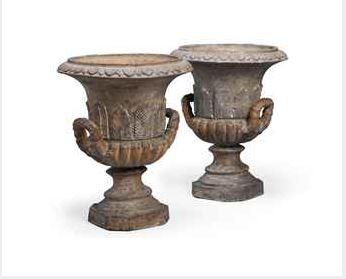
A pair of Scottish fluted terracotta pedestals by Garnkirk, Lanarkshire. 31 in. (79 cm.) high.
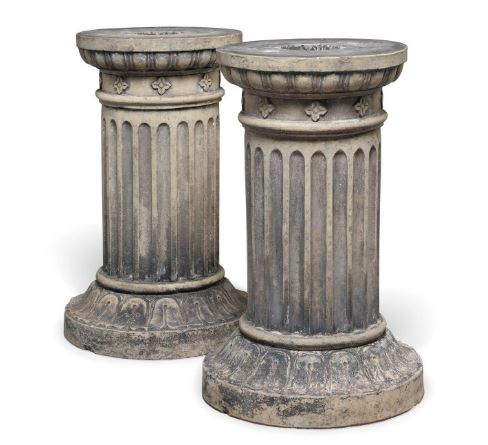
**************************************
The Garnkirk Colliery and Brickfield Company started exploiting the Glenboig / Garnkirk fireclays and making firebricks around 1831. The partnership was made up of Thomas Sprot, Mark Sprot, and James Murray. By 1833 the company was advertising a full range of products including firebricks of every descriptions, tiles, gas retorts, crucibles, water pipes, ornamental vases and chimney cans. In September of 1849, Murray severed his connection with the company. For most of its life, the company was noted as having an immense wholesale home and export trade.
By 1860 the company had agents in New York, Boston, Philadelphia, and Baltimore. In 1878 the principal overseas markets were in France, Germany, Russia, and the East and West Indies. Products are also noted as being shipped to New Zealand. By the 1860s the company was the largest fireclay firm in the world covering six acres, employing 300 men and boys, and manufacturing 200 tons of fireclay products each day.
By the late 1860s, the firm was surpassed by J. & M. Craig of Kilmarnock, which in turn was surpassed by the Glenboig Union Fire Clay Company in the 1880s. The Garnkirk fireclay pits were finally exhausted around 1895.
Apparently, the company went out of business around 1898 and the buildings were being advertised for sale in the spring of 1901. Garnkirk Fireclay Works noted as being built over by 1979.
*************
































































